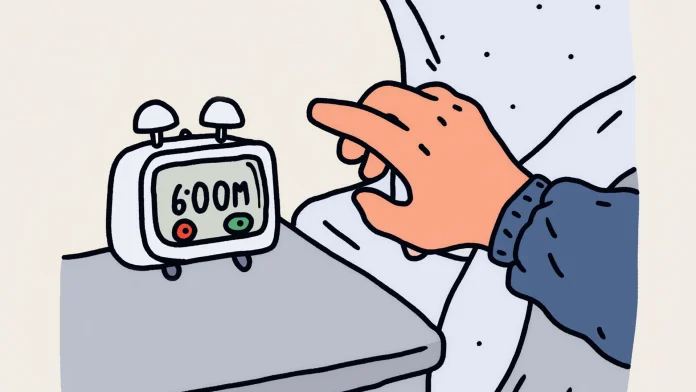Written by Malena Sanchez Moccero
Medically reviewed by Susana Pontiggia (Psychologist, Specialist in Neuroscience and Human Behavioral Sciences, Consultant in Personal and Organizational Development)
Art by Jouli Di Marco
In a time when we’re constantly glued to our phone screens, even a short break from them can feel both courageous and necessary. Smartphone addiction has become a serious concern, with consequences like anxiety, stress, and disconnection from real life. But what’s driving this dependency? And how can we build a healthier relationship with our phones?
Reaching for our phones has become second nature—we check them in waiting rooms, bathrooms, on public transportation, while watching TV, and even during conversations with friends and family. This constant use not only reduces productivity but also weakens our connection with the people and world around us.
According to a Pew Research Center study, 31% of adults say they use their smartphones almost constantly throughout the day. The first thing many of us do upon waking up is check our phones. At night, instead of winding down, we scroll through social media, prolonging our screen time.
In 2022, over three-quarters of the global population owned a mobile phone, according to the United Nations’ International Telecommunication Union (ITU). Another Pew study found that about three in ten U.S. adults are “almost constantly” online.
While technology has undoubtedly improved how we communicate, it has also given rise to challenges like smartphone addiction—often referred to as nomophobia. This compulsive urge to check our phones can negatively impact work, studies, and relationships. If you find yourself spending more time on social media or gaming than interacting with real people—or if being without your phone causes you distress—it may be time to reevaluate your digital habits.
What Is Nomophobia?
Nomophobia—short for “No Mobile Phone Phobia”—describes the anxiety or fear people experience when they’re without their phone or unable to use it. Coined in 2008, this term refers to what’s now recognized as a modern psychological disorder. Research suggests that around 60% of people may be affected by this irrational fear of being disconnected from their devices or the internet.
Nomophobia is often linked to underlying psychological factors such as low self-esteem, lack of confidence, and perfectionism. In clinical settings, it’s typically addressed with psychotherapy, focusing on reducing anxiety, strengthening self-control, and improving frustration tolerance.
A large-scale meta-analysis published in 2021, which reviewed 20 studies from 10 countries and included 12,462 participants, found that approximately 70.76% of individuals experience moderate to severe nomophobia. About 20.81% suffer from severe cases, with university students among the most affected—25.46% of them experience severe nomophobia.
Are You Lost In The World Like Me? Signs You May Be Suffering from Nomophobia
- Feeling anxious, depressed, or isolated when you don’t have access to your phone.
- Experiencing headaches or emotional distress when separated from your device.
- Waking up during the night to check your phone.
10 Tips to Build a Healthier Relationship with Your Phone
Treating nomophobia can significantly improve your quality of life. By building healthier habits, you can strengthen relationships, boost your academic or professional performance, and enhance your overall well-being. If the addiction feels unmanageable, seeking professional support is a wise step.
- Track Your Screen Time: Use apps like Moment (iPhone) and OFFTIME (Android) to monitor how much time you’re spending on your phone.
- Set Phone Usage Goals: Try limiting non-essential screen time to 30–60 minutes per day.
- Engage in Offline Activities: Catherine Price, author of How to Break Up with Your Phone, suggests redirecting screen time to hobbies like hiking, drawing, cooking, or spending quality time with loved ones.
- Turn Off Notifications: Disable alerts for email, social media, and games to reduce distractions and interruptions.
- Create No-Phone Zones: Designate areas like the dining table or bedroom as phone-free zones, and consider setting rules such as no phones after 6 p.m.
- Uninstall Non-Essential Apps: Delete time-consuming apps, particularly social media or games, to curb compulsive usage.
- Use an Alarm Clock Instead of Your Phone: This helps avoid morning scrolling and supports better sleep hygiene.
- Go Out Without Your Phone: Take walks, attend events, or catch up with friends without carrying your device.
- Use Screen-Limiting Apps: Tools like Freedom or Quality Time can help restrict access to distracting content.
- Switch to Grayscale Mode: Studies show that turning your screen to black and white can reduce phone use by up to 18%.
I Want To Break Free: Digital Detox Initiatives
Across the globe, a variety of initiatives are encouraging digital disconnection. Some parents are postponing smartphone access for their children to prevent anxiety and limit exposure to harmful content. Schools and workplaces are adopting phone-free policies, requiring people to store their phones during the day.
- Desconecta Program (Spain): Led by psychologist Marc Masip, this program offers detox camps with activities like sports, meditation, and psychological counseling.
- Digital Detox Movement (USA): Founded in San Francisco in 2012, this initiative promotes mindful disconnection from digital devices.
- Martin Talk’s Digital Detoxing (UK): Offers three-day minimum “digital breaks” to help participants reset their tech habits.
- Tanya Goodin’s Time to Log Off (UK): Organizes tech-free retreats to curb digital dependency.
The Benefits of a Digital Detox
Reducing screen time can lead to a range of mental, emotional, and lifestyle improvements:
- More Free Time
- Lower Anxiety and Stress Levels
- Improved Mood and Mental Clarity
- Stronger Connection with the Real World
Disconnect to Reconnect
Taking a break from screens—whether for a few minutes or a few days— can have a lasting impact on your mental and physical well-being. From spending quality time with family or friends to rediscovering your favorite hobbies, or simply allowing your mind to rest, stepping away from constant digital stimulation helps you reconnect with what really matters. In a hyperconnected world, sometimes the best thing you can do is unplug.
Recommended Books on Digital Disconnection
- Digital Minimalism, by Cal Newport
- How to Break Up with Your Phone, by Catherine Price
- The Shallows: What the Internet Is Doing to Our Brains, by Nicholas Carr
- Reclaiming Conversation: The Power of Talk in a Digital Age, by Sherry Turkle






